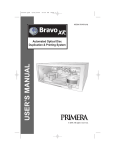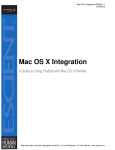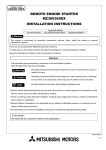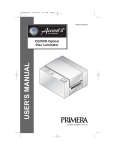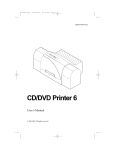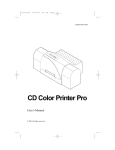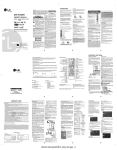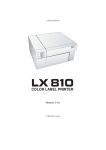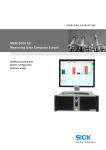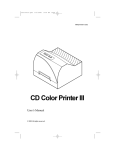Download Primera OptiVault User`s manual
Transcript
510934.qxd 10/28/2005 12:13 PM Page i USER’S MANUAL 102005-510934-(01) © 2005 All rights reserved. 510934.qxd 10/28/2005 12:13 PM Page ii Notices: The information in this document is subject to change without notice. NO WARRANTY OF ANY KIND IS MADE WITH REGARD TO THIS MATERIAL, INCLUDING, BUT NOT LIMITED TO, THE IMPLIED WARRANTIES OF MERCHANTABILITY AND FITNESS FOR A PARTICULAR PURPOSE. No liability is assumed for errors contained herein or for incidental or consequential damages in connection with the furnishing, performance, or use of this material. This document contains proprietary information that is protected by copyright. All rights are reserved. No part of this document may be photocopied, reproduced, or translated into another language without prior written consent. Trademark Acknowledgments: Windows is a registered trademark of Microsoft Corporation. All other trademarks are the property of their respective owners. Printing History Edition 1.1, #102005, ©Copyright 2005, All rights reserved. FCC Compliance Statement: This device complies with part 15 of the FCC rules. Operation is subject to the following two conditions: (1) this device may not cause harmful interference, and (2) this device must accept any interference received, including interference that may cause undesired operation. For Users in the United States: This product is intended to be supplied by a UL listed Direct Plug-In Power Supply marked "Class 2"or a UL listed ITE Power Supply marked "LPS" with output rated 12VDC, 4.5A or higher. This equipment has been tested and found to comply with the limits for a Class B digital device, pursuant to Part 15 of the FCC Rules. These limits are designed to provide reasonable protection against harmful interference in a residential installation. This equipment generates, uses, and can radiate radio frequency energy and, if not installed and used in accordance with the instructions, may cause harmful interference to radio communications. However, there is no guarantee that interference will not occur in a particular installation. If this equipment does cause harmful interference to radio or television reception, which can be determined by turning the equipment off and on, the user is encouraged to try to correct the interference by one or more of the following measures: • Re-orient or relocate the receiving antenna. • Increase the separation between the equipment and receiver. • Connect the equipment into an outlet on a circuit different from that to which the receiver is connected. • Consult the dealer or an experienced radio/TV technician for help. Use of shielded cables is required to comply with the Class B limits of Part 15 of the FCC Rules. You are cautioned that any changes or modifications not expressly approved in this manual could void your authority to operate and/or obtain warranty service for this equipment. For Users in Canada: This digital apparatus does not exceed the Class B limits for radio noise for digital apparatus set out on the Radio Interference Regulations of the Canadian Department of Communications. Le present appareil numerique n'emet pas de bruits radioelectriques depassant les limites applicables aux appareils numeriques de la class B prescrites dans le Reglement sur le brouillage radioelectrique edicte par le ministere des Communications du Canada. Note: To ensure the unit operates within FCC limits, the power supply should be kept at least 10 cm away from the metal case. CAUTION! TO PREVENT FIRE OR SHOCK HAZARD, DO NOT EXPOSE THE UNIT TO RAIN OR MOISTURE. TO REDUCE THE RISK OF ELECTRIC SHOCK, DO NOT REMOVE EXTERIOR PANELS. NO USER-SERVICEABLE PARTS INSIDE. REFER SERVICING TO QUALIFIED SERVICE PERSONNEL. OPERATE THE UNIT WITH ONLY THE PROPER ELECTRICAL SPECIFICATIONS AS LABELED ON THE PRINTER AND AC ADAPTER. CAUTION! THIS PRODUCT CONTAINS A LASER DIODE OF A HIGHER CLASS THAN 1. TO ENSURE CONTINUED SAFETY, DO NOT REMOVE ANY COVERS OR ATTEMPT TO GAIN ACCESS TO THE INSIDE OF THIS PRODUCT. REFER ALL SERVICING TO QUALIFIED PERSONNEL. THE FOLLOWING LABEL APPEARS INSIDE YOUR UNIT: CLASS 1 LASER PRODUCT LASER KLASSE 1 CAUTION! USE OF CONTROLS OR ADJUSTMENTS OR PERFORMANCE OF PROCEDURES OTHER THAN THOSE SPECIFIED HEREIN MAY RESULT IN HAZARDOUS RADIATION. ii 510934.qxd 10/28/2005 12:13 PM Page iii Table of Contents Section 1: Getting Started ...............................................................................1 A. Choosing a Good Location ................................................................1 B. Unpacking and Inspection.................................................................1 C. Identifying the Parts ...........................................................................2 D. PC System Requirements...................................................................4 E. Overview of Robotic Operation........................................................4 Section 2: Hardware and Software Set-Up .................................................7 A. Installing the PC Software .................................................................7 B. Hardware Setup ..................................................................................7 Step 1: Applying Power .....................................................................7 Step 2: Loading Media .......................................................................8 Step 3: Installing Ink Cartridges .......................................................9 Step 4: Connecting the USB Cable....................................................9 C. Opening the Software for the First Time.......................................11 D. Reloading Media ...............................................................................12 Section 3: OptiVault Printer Driver ............................................................14 Section 4: Using Retrospect..........................................................................17 A. Performing a Backup ........................................................................17 B. Restoring a Backup ...........................................................................25 C. Using Backup Scripts........................................................................29 D. Performing an Exchange Server Backup .......................................31 E. Backup Strategies ..............................................................................38 F. Adding Clients...................................................................................47 G. Progressive Backup...........................................................................52 H. Viewing System Errors.....................................................................53 Section 5: Interpreting the OptiVault’s Indicator Lights .......................55 Section 6: Maintenance and Troubleshooting ..........................................56 A. Cleaning the OptiVault ....................................................................56 B. Performing a Robotic Self-Test ........................................................56 C. Cleaning the Ink Cartridges ............................................................57 D. Technical Support..............................................................................57 Section 7: Technical Specifications .............................................................58 Index..................................................................................................................59 iii Interactive.qxd 9/6/2005 3:30 PM Page 1 Interactive Feature in this PDF Document There are interactive features that will allow you to jump to different locations within the document. Each listing in the Table of Contents is interactive. Place the cursor on either the words or the page number. A small hand with a pointing finger icon appears. Click on the line with the icon and the document will jump to that page. If you want to return to the Table of Contents, move the icon to the top of the page and click on the arrow marked TOC. Navigating through the Index is similar. Place the icon on one of the listings or page numbers, click on it, and it will move to that page. The text relating to the Index listing will appear in red. Returning to the Index can be done by clicking on the arrow marked Index. 510934.qxd 10/28/2005 12:13 PM Page 1 TOC INDEX Section 1: Getting Started THANK YOU… ...for purchasing the OptiVaultTM . The OptiVault and Retrospect together are the perfect professional backup and archival solution for servers and desktop computers. A. CHOOSING A GOOD LOCATION • • Place the OptiVault in a location with adequate air circulation to prevent internal heat build up. Do not place the OptiVault near heat sources such as radiators or air ducts, or in a place subject to direct sunlight, excessive dust, mechanical vibration or shock. B. UNPACKING AND INSPECTION While unpacking your OptiVault, inspect the carton to ensure that no damage has occurred during shipping. Make sure that all supplied accessories are included with your unit. The following items should be included: • • OptiVault Gray Plastic Input and Output Bins (Located inside the cardboard insert) • Switching Power Supply with Power Cord • One Three-Color (CMY) Ink Cartridge • One Monochrome Black Ink Cartridge • QuickStart Installer Disc • USB 2.0 Interface Cable • Warranty Card • 10 Pack Primera TuffCoat Archival Media • This Operator's Manual, Quick Start Guide and Other Printed Information Save the carton and packing materials. They will come in handy later if you ever need to transport the OptiVault and/or any of its parts and accessories. Getting Started 1 510934.qxd 10/28/2005 12:13 PM Page 2 INDEX TOC C. IDENTIFYING THE PARTS Front Panel and Top This illustration shows the Optivault, its Control Panel, Buttons, LED indicator lights, Input and Output Bins and other components. Ink Cartridge Carrier Input Bin Ink Cartridge Button Output Bin Control Panel Robotic Disc Transporter Power Button Front Cover LED Status Lights Color Ink Cartridge Monochrome Black Cartridge Control Panel Lock Reject Area CD/DVD Recorder Recorder Tray Button The Robotic Disc Transporter moves discs from the Input Bin, to a CD/DVD Recorder, to the printer, and finally to the Output Bin. The CD/DVD Recorder is automatically loaded and unloaded by the Optivault’s Robotic Disc Transporter. The Recorder Tray Button manually opens or closes the Recorder Tray. In normal operation, the in/out movement of the Recorder Tray is controlled automatically and this button is not used. The Control Panel contains LED Status Lights and Buttons to control the Optivault. The right LED Status Light indicates that Power is ON. The left LED Status Light is on to indicate that the cover is closed. They also blink in certain patterns to indicate an error or other condition of the Optivault. See Section 5 for a full explanation of the LED Status Light conditions. 2 Getting Started 510934.qxd 10/28/2005 12:13 PM Page 3 INDEX TOC The Power Button turns the Optivault's power OFF if pressed and held for five seconds. Press it quickly to turn power back on. When already powered on quickly pressing the power button will move the arm to the right or the middle to allow access to the recorder drive or the bins. When the front cover is opened, the Ink Cartridge Button is used to position the Cartridge Carrier for easy ink cartridge replacement. When the front cover is closed, pressing the Ink Cartridge button will open or close the Printer Tray. (Must override cover lock sensor to simulate cover closed condition) The Input/Output Bins are situated under the top cover of the Optivault. The bins will hold up to 25 discs. The right-side bin is the Input Bin for blank media; the left-side bin is the Output Bin for finished discs. Only a total of 25 discs can be loaded into the input bin, output bin and drive at any one time. The Reject Area is where discs are dropped if the header information is not burned correctly or if the minimum size threshold is not met. (100MB) . The discs slide down the ramp out in front of your Optivault. The Front Cover is a durable plastic cover that will protect the Optivault from dust and interference. The Ink Cartridge Carrier holds both a color ink cartridge (left-side pen) and a monochrome ink cartridge (right-side pen). Rear Panel This illustration shows the input ports found on the rear panel of the OptiVault: USB 2.0 Port Power Input Port The USB 2.0 Interface is connected to an open USB 2.0 port on your PC with the USB 2.0 cable, included with your Optivault. The Power Input Port connects to the included 100V~240V 12V switching power supply. Getting Started 3 510934.qxd 10/28/2005 12:13 PM Page 4 TOC INDEX D. PC SYSTEM REQUIREMENTS Before getting started, it is important for you to verify that your PC meets the minimum system requirements. • 1 Ghz or faster Pentium IV processor running Windows 2000 or X, Server 2000 or 2003. • 512 MB or greater RAM • Free hard drive space of at least 10 GB. • Available USB 2.0 Port. If your PC does not have at least these minimum system requirements, system performance may not be acceptable. Client software for other operating systems is available from the EMC Dantz website. E. OVERVIEW OF ROBOTIC OPERATION The following is a description of the complete sequence of the robotic arm, drive and disc tray during normal backup operation. 1. The Backup Appliance's integrated Robotic Disc Transporter will pick a disc from the Input Bin. 2. The Recorder Tray opens automatically and the Robotic Disc Transporter places a disc into the recorder. 4 Getting Started 510934.qxd 10/28/2005 TOC 12:13 PM Page 5 INDEX 3. The Recorder Tray then automatically shuts. Robotic Disc Transporter will automatically check the Input Bin to make certain that only one disc was picked. The software checks the disc to make sure it is blank and then burns header information to the disc. 4. If the header information burn was successful the Robotic Arm will pick the disc from the recorder and place it into the Printer. 5. Backup job information is then printed onto the disc. The title you choose is printed followed by a dash and the number this disc is in the backup set. For example the first disc in the backup set might be named 1-My Backup. 6. The Robotic Arm then moves the printed disc back into the recorder to write the files contained on the source volume. 7. Once the writing is complete the disc is moved to the output bin. Getting Started 5 510934.qxd 10/28/2005 TOC 12:13 PM Page 6 INDEX 8. The process is repeated for each necessary disc in the backup set. 9. After all discs are written, the discs are picked from the left bin and placed in the right bin to simulate the original order. 10. Each disc is then picked and placed in the recorder for verification by the software and then placed into the left bin when finished. 11. After the last disc is verified it remains in the recorder so that it can be appended to during the next progressive backup of this backup set. 6 Getting Started 510934.qxd 10/28/2005 12:13 PM Page 7 INDEX TOC Section 2: Hardware and Software Set-Up This section will describe the step-by-step process of setting up your OptiVault. This includes information on how to load the supplies (ink and disc media) necessary to start producing discs. A. INSTALLING THE PC SOFTWARE The Installer Disc has a menu that will guide you through the process of setting up your OptiVault. Please refer to the following for more information on each step: 1. 2. Place the Installer CD in your CD-Rom Drive. The Installer application should automatically launch in a few moments. If it does, proceed to Step 2. If it does not automatically launch, follow these steps: • Double-click the My Computer Icon, then double-click the icon of the appropriate CD drive containing the Software Installer disc • Double-click Installer.exe In the Installer Application, click the Standard Install button. The Standard Install will guide you step-by-step through the installation process. As you complete each step, click the → Next arrow. Steps 1-4 are shown in section B below as well as on the monitor. You may follow either to complete the setup. B. HARDWARE SETUP To connect your new Optivault, please do the following: Be sure you have removed the packing tape and cardboard insert prior to applying power. Step 1: Applying Power • • • Locate the power adapter supplied with your Optivault. Place one end of the adapter cord into the power port on the rear panel of the Optivault. Unit will initialize for approximately 30 seconds. Hardware and Software Set-Up 7 510934.qxd 10/28/2005 12:13 PM Page 8 TOC INDEX Step 2: Loading Media (Discs) NOTE: Only a total of 25 discs can be loaded into the input bin, output bin and drive at any one time. For reliable, consistent operation of your OptiVault, we strongly encourage you to use only genuine Primera TuffCoat Archival Media available at www.primerastore.com. There are documented quality differences between different brands of media. Primera has not researched the archival life nor can it support the recording characteristics and/or performance of other brands of optical media. Refer to the following steps when loading discs in to the Optivault: • Open the front cover of the Optivault • The Optivault will automatically position the cartridge carrier and Robotic Disc Transporter to the center position allowing for easy access to the bins. • Load the Input Bin (the bin located on the right-hand side of the Optivault) with up to 25 blank discs and place the bins on the mounting pegs. 8 Hardware and Software Set-Up 510934.qxd 10/28/2005 12:13 PM Page 9 INDEX TOC Step 3: Installing Ink Cartridges • Press the Ink Cartridge Button to move the Ink Cartridge Carrier to the load position and open the ink cartridge covers • Remove each ink cartridge from its packaging • Slowly remove the tape covering the cartridge's print head, being careful to avoid damaging the barcode label on the underside of the cartridge. DO NOT TOUCH THE COPPER AREA! • Insert the ink cartridges into the carrier, copper end first and snap the cartridge cover in place. Insert the color in the left holder, monochrome black in the right cartridge holder. Color Black Pull out and lift up • Close the Optivault’s front cover. Step 4: Connecting the USB 2.0 Cable Connect the Optivault to your computer with the beige USB 2.0 Cable. Hardware and Software Set-Up 9 510934.qxd 10/28/2005 12:13 PM Page 10 TOC INDEX After a few moments a found new hardware wizard will appear. Select "Install the software automatically" and click Next. Make sure that you have your installation disc in a drive on your computer. You may see a notice like the one shown below stating that the device has not passed Windows Logo Testing. Click Continue Anyway to continue installing the printer driver for your Optivault. In the installer application, follow the steps shown on your monitor to complete the installation of the Retrospect and SureThing software. 10 Hardware and Software Set-Up 510934.qxd 10/28/2005 12:13 PM Page 11 INDEX TOC C. OPENING THE SOFTWARE FOR THE FIRST TIME The first time you open the software a wizard will guide you through several steps to complete the setup. Follow the steps and click Next to complete the setup. If you will be using the Exchange Database/Mailbox backup feature it is important that you enter the License code when prompted by the setup wizard to add more license codes. The License Code is HXN9-HJ4M-ANAJ-2TCX. Hardware and Software Set-Up 11 510934.qxd 10/28/2005 12:13 PM Page 12 TOC INDEX It is also important that the user logged in to run Retrospect has rights to access the Exchange Server. You can set Retrospect to always run as a user with these rights or run as the loggedin user. In either case make sure the user has necessary rights to access the Exchange server. D. RELOADING MEDIA Any time media is moved or removed from the OptiVault it is necessary to clear the media location memory before continuing backup operations. Use the following procedure each time you reload media: 1. Remove all discs from the backup set except for the last disc of each set. Put them in the left bin. Note: Burned discs could be in the right or left bin. 12 Hardware and Software Set-Up 510934.qxd 10/28/2005 TOC 12:13 PM Page 13 INDEX 2. Reload blank media in the right bin so the total number of discs in the unit does not exceed 25 discs. Remember, the last disc may be located in the drive so don't forget to include it in your media count! 3. Open Configure on the left navigation menu. Click Devices. 4. Click on Primera OptiVault to Highlight it. Click on the Initialize Elements button to clear the media location memory. Hardware and Software Set-Up 13 510934.qxd 10/28/2005 12:13 PM TOC Page 14 INDEX Section 3: OptiVault Printer Driver Once the Optivault software has been successfully installed, take a moment to familiarize yourself with the printer driver settings for your Optivault. Only the settings that affect the print quality of your discs are described below. You will see many other settings that will not need to be changed. The default settings of the Optivault printer driver will fit most printing needs. Please refer to the following steps to change or verify your printer driver options: 1. Click the Start button. For Windows 2000 point to Settings and click on Printers. For XP Professional click on Printers and Faxes. For XP Home click on Control Panel, then click on Printers and Other Hardware, then click on Printers and Faxes. Click on the OptiVault icon with the right mouse button and select Printing Preferences. Resolution Select the appropriate print quality option for your image. Keep in mind that Normal 600 provides the lowest quality but fastest print, and that Ultra Photo 4800 provides the highest quality but slowest print. 14 OptiVault Printer Driver 510934.qxd 10/28/2005 12:13 PM TOC Page 15 INDEX Cartridge Type Select Color to print using only the color cartridge. The Monochrome Black setting prints using the Monochrome Black cartridge only. Ink Saturation This option controls the ink saturation of the printed image. Please note that higher ink saturation results in higher ink usage. This will reduce the amount of discs produced per cartridge. Enable Ink Low Warning This setting lets you enable or disable the warning from the printer to tell you when the ink cartridges are getting low. Ink Levels and Cartridge Maintenance Select this button to display the current ink levels as well as options for cleaning and changing cartridges. Select Clean button to send a simple test pattern to the printer. Be sure to have a disc in the OptiVault’s input bin and the front cover closed. Select the Change button to install a fresh, new ink cartridge or to switch back and forth between previously used cartridges. After the cartridge has been replaced according to the instructions in section 2B, select either the New Cartridge Installed button or the Old Cartridge Installed button accordingly. These selections are necessary for the printer to accurately keep track of ink cartridge ink levels. Select the Details button for information on the drivers, firmware, alignment and number of discs printed with your Optivault. OptiVault Printer Driver 15 510934.qxd 10/28/2005 12:13 PM Page 16 INDEX TOC Alignment Calibration The Alignment Calibration allows you you create a test print that will provide you with values to configure your printer for Bi-Di- Printing and to align the color and black cartridges for Color+Black printing. If Bi-Di Printing is enabled, or if you use Color+Black as a cartridge type in the driver settings, it is important to perform this calibration every time you change a cartridge. To print, click the Alignment Calibration Properties button then click Yes.. The print will look like this: A B 0 0 4 8 12 1 5 9 13 2 6 10 14 3 7 11 15 2 4 6 8 10 12 14 2 4 6 8 10 12 14 C 0 D 16 OptiVault Printer Driver 0 2 4 6 8 10 12 14 510934.qxd 10/28/2005 12:13 PM Page 17 INDEX TOC Section 4: Using Retrospect A. PERFORMING A BACKUP 1. Load Media into the right bin of the Optivault. IMPORTANT NOTE ON MEDIA: Only a total of 25 discs can be loaded into the input bin, output bin and drive at any one time. For reliable, consistent operation of your OptiVault, we strongly encourage you to use only genuine Primera TuffCoat Archival Media available at www.primerastore.com. There are documented quality differences between different brands of media. Primera has not researched the archival life nor can it support the recording characteristics and/or performance of other brands of optical media. 2. Open Retrospect 3. Click on the Backup button on Backup Overview window or on the left navigation menu. 4. This screen will automatically display information about the last backup that was performed. You can change this information by selecting "Let me change these settings". When you click Next the wizard will guide you through all the steps necessary to setup a backup job. For this example we will use the Wizard Mode. Click the Help button on any step in Wizard Mode for more information on that step. Using Retrospect 17 510934.qxd 10/28/2005 12:13 PM Page 18 INDEX TOC To bypass the wizard, click Switch to Advanced Mode. Advanced Mode allows you to jump to specific settings you want to change without going though the wizard. Additional settings are also available in Advanced Mode which are not available in Wizard Mode. Wizard Mode Advanced Mode 18 Using Retrospect 510934.qxd 10/28/2005 TOC 12:13 PM Page 19 INDEX 5. This screen allows you to choose preset volumes that are commonly backed up or a specific location. Select "Let Me Choose”. Click Next. 6. Choose the specific location you would like to back up. For this example choose Local Disk (C:). To backup other computers on the network choose "My Network Places". To choose multiple locations, hold down the control key and click on each item you would like included in the backup. Click Next. Using Retrospect 19 510934.qxd 10/28/2005 12:13 PM TOC Page 20 INDEX If you would like to backup only specific folders on a computer/server, select the destination and then click Show folders. Choose the folder or folders you would like to define as volumes. Click Define. 7. Choose the type of files you would like included in the backup. Uncheck anything you would like to exclude. More specific exclusion options are available in Advanced Mode. Click Next. 20 Using Retrospect 510934.qxd 10/28/2005 TOC 12:13 PM Page 21 INDEX 8. Choose the destination by selecting the Optivault and clicking Next. 9. You may schedule a backup or choose to run it now. Select Now and click Next. Using Retrospect 21 510934.qxd 10/28/2005 12:13 PM TOC Page 22 INDEX 10. Name your Backup Set using this screen. Uncheck Use existing if you would like to create a new backup set. Note: See Section 4C for information on saving Backup Source and Destination information as one Backup Script. 11. Decide whether you would like to compress data. Data compression saves space in the Backup Set by compressing files before copying them into the Backup Set. Files are automatically decompressed back to their original state when restored. Backups (and restores) from Backup Sets using data compression are slower than those that do not. Click Next. 22 Using Retrospect 510934.qxd 10/28/2005 TOC 12:13 PM Page 23 INDEX 12. Choose a security policy if desired. Choosing a security password other than "None" will encrypt the data on disc and require the user to enter a password to perform a restore. Click the Help button for more information. Click Next to continue. 13. The final screen of the Wizard Mode will show a short summary of your chosen settings. Click Start Now to start the backup. Using Retrospect 23 510934.qxd 10/28/2005 12:13 PM TOC Page 24 INDEX 14. The software will first scan all the data to be backed up and then start the burn process. See section 1F for a description of the actual robotic burn and print backup process. While the backup is executing the Activity Monitor is displayed. If any errors are encountered click the Events Tab to view the event log. See section 4H for more information on event log errors. 24 Using Retrospect 510934.qxd 10/28/2005 12:13 PM Page 25 TOC INDEX B. RESTORING A BACKUP In the event that you need to restore a backup follow these steps: 1. Locate all of backup discs in a backup set. Discs will be titled according to the following example. If you have 5 discs in your backup set the title of each will be 1-My Backup, 2-My Backup, 3-My Backup, 4-My Backup and 5My Backup. The final disc in the backup set may already be in the recorder drive. If you store your backup discs offsite load them into the left bin of the backup device in this order: 4-My Backup 3-My Backup 2-My Backup 1-My Backup 5-My Backup or the last disc in the backup set should be placed in the recorder drive of the Optivault. Note: Whenever you move or remove media follow the reloading procedure in section 2D. 2. Open the Software. Choose Restore from the navigation menu on the left. Using Retrospect 25 510934.qxd 10/28/2005 12:13 PM Page 26 TOC INDEX 3. Click Next past the introduction screen. 4. You will be presented with a list of recently performed backups from which you can restore. Select one and click Next. 5. If you have chosen to progressively backup files you will have several snapshots or time points to restore to. Choose one. Click Next. 26 Using Retrospect 510934.qxd 10/28/2005 TOC 12:13 PM Page 27 INDEX 6. Choose the location you would like to restore to on your hard drive or network. The most common choice here would be Original Location. Click Next. 7. Choose Restore Files and Folders to choose the files you would like to restore. Choose Restore everything… to restore all files. This option will cause the next step to be skipped. In this example we will choose Restore Files and Folders. Click Next. Using Retrospect 27 510934.qxd 10/28/2005 12:13 PM TOC Page 28 INDEX 8. Choose the files and folders you would like to restore. Click Next. 9. Choose whether you would like to replace matching files. Click Next. 10. The final screen before you start the restore summarizes your restore settings. Click back to edit any settings. Click Start to start the restore. 28 Using Retrospect 510934.qxd 10/28/2005 12:13 PM Page 29 TOC INDEX C. USING BACKUP SCRIPTS Using Backup Scripts is an easy way to save all the settings associated with several different backup jobs. Use this feature if you would like to schedule backups on several different volumes on a regular basis. 1. Choose Manage Scripts from the left navigation menu. 2. Choose to edit an existing script or create a new one. For this example we will choose to create a new script. Using Retrospect 29 510934.qxd 10/28/2005 12:13 PM Page 30 INDEX TOC 3. Choose the type of script you would like to create. For this example we will choose a standard backup script. 4. Type the name of the script. 5. At this point you are brought to a standard backup window in advanced mode. Switch to Wizard mode and use the steps in section 4A to complete the backup or setup your backup job in Advanced Mode. 30 Using Retrospect 510934.qxd 10/28/2005 TOC 12:13 PM Page 31 INDEX To edit your backup script, click Manage Scripts, select the name of the script and click Edit. D. PERFORMING AN EXCHANGE SERVER BACKUP The Optivault is especially useful for backing up Exchange. Below are the steps necessary to perform this function. Before setting up the Exchange backup make sure that you have the necessary Exchange backup license installed. Go to the Window Menu – choose License Manager. Using Retrospect 31 510934.qxd 10/28/2005 12:13 PM Page 32 INDEX TOC Make sure the Exchange Database/Mailbox Backup license shows 0 used, 1 available. If you do not have the license installed click Add and enter code provided in section 2D. 1. Install the client software on the Exchange server using the instructions in section 4F. You will need it to add the client in Step 5. 2. Make sure the user logged into Retrospect has necessary rights to the Exchange server. The server may not appear as an available source unless the user has rights to the server. 3. Add the Exchange Server as a client. Open Configure on the left navigation menu. Choose Clients. Click Add on the screen below: 32 Using Retrospect 510934.qxd 10/28/2005 12:13 PM Page 33 INDEX TOC 4. Retrospect will automatically display the clients with the client software installed. If you do not see the client see section 4F for instruction on how to directly add the client. 5. Highlight the Exchange server client and choose Add. You will be prompted for a password. 6. Go to the Automate menu – choose Manage Scripts. 7. Click the New button to add a script. Using Retrospect 33 510934.qxd 10/28/2005 12:13 PM Page 34 TOC 8. Choose Backup as the script type. 9. Name your backup script. INDEX 10. Switch to Advanced Mode if you are in Wizard Mode. Click Sources. 34 Using Retrospect 510934.qxd 10/28/2005 TOC 12:13 PM Page 35 INDEX 11. You may back up the Exchange Server and the Exchange Mailboxes. In order to backup mailboxes you must add them to the Mailbox list. To add specific Mailboxes Highlight the Exchange Mailbox and click Mailboxes… Note: While Mailbox data is contained in the backed up Server database, it is recommended that you back up specific Mailboxes in addition to the server. This makes it much easier to restore specific mailbox items if they are accidentally deleted by the user. 12. All available Mailboxes will be displayed. Highlight one or several and click Define. Using Retrospect 35 510934.qxd 10/28/2005 12:13 PM TOC Page 36 INDEX 13. You may also backup items within the specific user mailbox. In this example only the Administrator Mailbox was defined. Highlight the specific mailbox and choose Subvolume… 14. Highlight the items in the Mailbox you would like to backup. Choose Define. 36 Using Retrospect 510934.qxd 10/28/2005 TOC 12:13 PM Page 37 INDEX 15. After you have defined all mailboxes and subvolumes, you are ready to add them as Sources. Highlight (Control Left Click) each of the items you would like included as sources. Click OK. 16. Set the Destination, Selecting and Options as described in section 4A. Set the schedule according to the suggested backup strategies described in section 4E. Using Retrospect 37 510934.qxd 10/28/2005 12:13 PM Page 38 INDEX TOC E. BACKUP STRATEGIES Often it is beneficial to develop a backup strategy to backup important files. Below are a several strategies well suited to the OptiVault. E1. Hard Drive to Hard Drive to Optical Disc (DVD) This strategy involves two scripts. The first script "Hard Drive" will backup information from any source to a hard drive on your network. It is recommended that you dedicate a large, fast hard drive for this purpose. The second script "Optical Disc" will backup selected or filtered information to a permanent place. In this example we filtered all documents except MS Word documents. Schedule the hard drive backup five times a week and the Optical disc backup once a week. The backup strategy allows you to keep all data instantly accessible and important data safely stored on permanent transportable media. Follow these steps to implement this strategy: 1. Setup the "Hard Drive" script according to the instructions in 4C except for one difference. Set the destination Backup Media to Disk instead of CD/DVD. 38 Using Retrospect 510934.qxd 10/28/2005 TOC 12:13 PM Page 39 INDEX 2. Name your backup set destination and select the hard drive by clicking the Select button. 3. Choose what you want to do when the hard drive becomes full. Choose "Keep according to Retrospect's defined policy" to delete old files only as it becomes necessary to do so. Using Retrospect 39 510934.qxd 10/28/2005 12:13 PM TOC Page 40 INDEX 4. Schedule this script to run Monday through Friday. 5. To create the second script go to the Automate menu choose Manage Scripts. Click New. 6. Choose "Transfer Backup Sets" as the type of script. 40 Using Retrospect 510934.qxd 10/28/2005 12:13 PM Page 41 TOC INDEX 7. Name your script 8. Select the Source by clicking the Source button. 9. Select which backup set you would like as your source. Choose the backup set you designated as your destination in steps 1-4. Using Retrospect 41 510934.qxd 10/28/2005 12:13 PM TOC Page 42 INDEX 10. Create a new backup set as your Optical Disc backup set. Select it as your destination. 11. You may want to filter out certain file types such as mp3 or video files. You may also want to include only certain file types such as word documents. This can reduce the size of your optical disc backup set. In this example only word documents were included in the transfer. Click Selecting to filter out or include certain file types or locations. 42 Using Retrospect 510934.qxd 10/28/2005 12:13 PM Page 43 TOC INDEX 12. Finally, schedule this script to run once a week on a Friday. All but the last disc in this backup set can be stored offsite. E2. Rotating onsite and offsite This strategy involves two scripts. The first script "Week 1" will back up information from your source to optical disc backup set named "Week 1". This script will be scheduled to run Monday through Friday every other week. The second script "Week 2" will back up information from the same source to a different optical disc backup set named "Week 2". This script will be scheduled to run Monday through Friday every other week starting the next week. "Week 1" and "Week 2" would rotate backing up the same data every week. Using this strategy you can take the "Week 1" backup set of discs to secure offsite storage during "Week 2" backups and vice versa for the "Week 2" backup set when "Week 1" is running. During the first run each week the backup set will catch up to the last one using progressive backup technology. Using Retrospect 43 510934.qxd 10/28/2005 12:13 PM Page 44 TOC INDEX Follow these steps to implement this strategy: 1. Setup both backup scripts using the instructions in section 4C. The source for each set will be the same. The destination will be different. 2. Set the first week to run Monday through Friday starting on a specific Monday. Set the weeks to "2" so that the backup occurs every other week. 3. Set the second week to run Monday through Friday starting one week later. Set the weeks to "2" so that the backup occurs every other alternate week. 44 Using Retrospect 510934.qxd 10/28/2005 12:13 PM Page 45 INDEX TOC E3. Progressive daily - New weekly This strategy involves one script. This script will backup information from your source to your backup set. Schedule a normal progressive backup Monday through Thursday. Schedule the same script for a Full backup every Friday. Each will have separate names. If the backup set is named My Documents, the new Full backup will be named My Documents-001. Each full backup will add a number after the name - My Documents-001, My Documents-002, etc. You may extend this schedule so that a full backup only occurs once a month or at whatever time you want. This strategy is useful to reduce the size of your backup set. Once the full backup occurs, the progressive backup starting Monday will use full backup as starting point. In other words you can take the previous Friday - Thursday set offsite because they are no longer needed in the new set. Follow these steps to implement this strategy: 1. Setup a backup script using the instructions in Section 4C. 2. Schedule the script to run Monday through Thursday as shown below. Set the Action to Normal (default). Using Retrospect 45 510934.qxd 10/28/2005 12:13 PM TOC Page 46 INDEX 3. Add another schedule to the same script by clicking the Add button. Set this script to run on Friday. Set the Action to New Backup Set. 4. Your final schedule should look like the screen below: 46 Using Retrospect 510934.qxd 10/28/2005 12:13 PM Page 47 INDEX TOC F. ADDING CLIENTS After you register with EMC Dantz you will be provided a license code to unlock two free clients for use with desktop computers. Once you receive the license code, open the Retrospect software. Go to the Window Menu - choose License Manager. Click Add… on the License Manager Window Using Retrospect 47 510934.qxd 10/28/2005 12:13 PM Page 48 TOC INDEX Enter your license code and click OK to add the license. NOTE: It is possible to backup specific shared files and folders on desktop computers connected to your network without installing clients. However, without backup clients, it is not possible to backup the system state necessary for a complete operating system restore. To install clients on a PC Insert the installation disc. Choose Custom Install from the main installer window. Choose Install Retrospect 7.0. From the Retrospect install windows choose Install Retrospect Client. During the install you will be asked to choose a password. Remember it, you will need it to backup the client. 48 Using Retrospect 510934.qxd 10/28/2005 12:13 PM Page 49 TOC INDEX To install clients on a Macintosh Go to the EMC Dantz website. www.emcdantz.com Browse to the Support area - choose Updates - Choose the Mac client. Download and install the client. During the install you will be asked to choose a password. Remember it, you will need it to backup the client. Note: This client installation can be installed on as many desktop or server computers as you would like included in a backup. The installer is the same for servers or desktops. However, the Retrospect software license manager will only allow you to backup to two of the installed desktop clients. To purchase additional desktop client or server client licenses, contact your reseller or EMC Dantz. Using Retrospect 49 510934.qxd 10/28/2005 12:13 PM Page 50 TOC INDEX Add the Client to the Backup Client List 1. Before you can backup a client you need to add the client to the Backup Client List. Open Configure on the left navigation menu. Choose Clients. Click Add on the screen below: 2. Retrospect will automatically display the clients with the client software installed. 50 Using Retrospect 510934.qxd 10/28/2005 TOC 12:13 PM Page 51 INDEX 3. Highlight the client and choose Add. You will be prompted for a password. 4. If you do not see the client on the list click the Advanced button. 5. Now click on Direct. Type in the IP address or DNS of the client computer. Click Add. Using Retrospect 51 510934.qxd 10/28/2005 12:13 PM Page 52 TOC INDEX 6. If Retrospect finds the client, you will be prompted for a password. You will be asked to confirm the name of the client. Client properties will be displayed. Click Done. 7. You will now see clients you added in the Backup Client List in the sources window. G. PROGRESSIVE BACKUP Progressive When Retrospect performs a backup for the first time everything selected from the source is backed up to the Backup Set. Progressive Backup means that every time you backup after the first time, Retrospect intelligently copies only files that are new or have changed since the previous backup to a Backup Set. You don't have to specify whether you want a "full" or "incremental" backup. Retrospect, by default, copies any and all the files it hasn't already backed up. For this reason the last disc written to in the backup set is left in the recorder. If not many files have been added or changed and if the backup is performed frequently, it is very likely that the last disc will stay in the recorder through several backups cycles of this set. 52 Using Retrospect 510934.qxd 10/28/2005 12:13 PM Page 53 TOC INDEX H. VIEWING SYSTEM ERRORS If Retrospect ever encounters a problem in the backup process the error is recorded in the event log. During a backup, the activity monitor is displayed. To view the event log click on the Events Tab at the top of the Activity Monitor. In this example the cover on the Optivault's front cover is open. Notice the red X next to the error. You can easily scan the event log for this error symbol to find the reason your backup job has not completed. If you suspect that the software is not communicating with the Optivault, you can check the Optivault status by clicking on Devices under Configure on the left navigation menu. If the Optivault is communicating correctly, Primera Optivault will be displayed with the drive model shown underneath. Using Retrospect 53 510934.qxd 10/28/2005 12:13 PM TOC Page 54 INDEX If the media request dialog appears on top of the activity monitor during a job (see screen capture below) and you are sure the media asked for is in the OptiVault, use the procedure in section 2D, step 3 and 4 to Initialize Elements. This will cause the OptiVault to immediately search for the media and continue the backup job. 54 Using Retrospect 510934.qxd 10/28/2005 12:13 PM Page 55 INDEX TOC Section 5: Interpreting the Optivault's Indicator Lights The Power and Busy LED indicator lights located on the top of the Optivault can tell you a lot about what is happening inside the Optivault. To accurately interpret what it means when these lights are on, off, or flashing, please refer to the following: Power LED Ink Cartridge LED Optivault on solid off Cover is open on solid on solid Is ready to receive job. both lights are blinking alternately with one another Waiting for a cartridge to be installed and the lid to be closed. (See section 2-E). on solid flashing rapidly The printer tray or ink cartridge carrier has stalled. Open and close the cover to retry the operation. flashing rapidly on solid The Optivault has a cartridge problem. Check to make certain that the cartridges are installed correctly and that the bar code labels on the underside of the cartridge are not damaged. repeating pattern of both lights flashing in unison, then one light momentarily on solid. This indicates low ink warning. If the left light stays solid after the flash, the Color cartridge is low. If the right light stays on after the flash, the Black Monochrome cartridge should be replaced. Interpreting the OptiVault’s Indicator Lights 55 510934.qxd 10/28/2005 12:13 PM Page 56 INDEX TOC Section 6: Maintenance and Troubleshooting The Optivault is designed to operate for extended periods of time with very little attention. In fact, no regular maintenance is recommended other than cleaning the outside case. NOTE: Do NOT attempt to oil or grease the Optivault's Robotic Arm shaft or other components. You will likely cause more harm than good! Any moving parts are designed to operate for the life of the machine with no additional lubrication required. A. CLEANING THE OPTIVAULT Use a clean, lint-free rag with a small amount of ammonia window cleaner to clean the Optivault's outside case and trays. This type of cleaner is very effective on inks that may accumulate on the printer tray. Stronger cleaning solutions are NOT recommended because they may damage the paint and plastic materials from which the parts are manufactured. Always disconnect your Optivault’s power cords before cleaning. Resume operation only after the surfaces are completely dry. B. PERFORMING A ROBOTIC SELF-TEST To ensure that everything is working properly, a Self-Test feature is built in to your Optivault. In this mode, the Robotic Disc Transporter will go through the motions of picking and placing a disc to ensure proper working order. This test may be performed without connecting the Optivault to the computer. Perform the test by doing the following steps: • • • • Load some discs into the Input Bin The cover must be closed for this operation to complete. However, in order to access the buttons you must open the cover. To get around this problem simulate closing the cover by activating the cover lock sensor. You may do this by putting an object such as a folded piece of paper in the slot where the lock would normally be located. With the Optivault turned on, press the Cartridge Button While holding the Cartridge Button, press the Power Button until the robotics start to move. 56 Maintenance and Troubleshooting 510934.qxd 10/28/2005 12:13 PM Page 57 INDEX TOC • • Release both buttons To stop the test, wait until the disc has moved to the Output Bin and press the Power Button. C. CLEANING THE INK CARTRIDGES It may be necessary to clean the ink cartridge nozzles if you notice reduced print quality, or if you suspect an cartridge nozzle has become slightly dried out or clogged. Remove the cartridges and blot the nozzles on a wet paper towel until you start to see all three colors evenly appearing on the paper towel. D. TECHNICAL SUPPORT If you have difficulties in operating the Optivault use the procedures in this manual and the additional resource listed below: Technical Support Additional Resources Source Location Primera Knowledge Base www.primera.com/knowledgebase.html SureThing Software Help files Open the software. Click on the Help Menu - Contents Retrospect Software Help File Open the software. Click on the Help Menu - Contents Retrospect Manual (pdf) Installation CD Retrospect Knowledge Base Open the software. Click on the Help Menu - Online Knowledgebase Email Support www.primera.com/contact_tech_support.cfm Chat Support www.primera.com/knowledgebase.html Primera Level 1 Phone Support 763-475-6676 (Mon - Fri 8 a.m. - 6 p.m CST) Dantz Level 2 Phone Support 888-777-5664 (Mon-Fri 8 a.m. -6 p.m.) Retrospect Only - Cost involved. Maintenance and Troubleshooting 57 510934.qxd 10/28/2005 12:13 PM Page 58 INDEX TOC Section 7: Technical Specifications Model Optivault Printing Method Ink-Jet Printing Resolution 4800 x 1200 dpi, 2400 x 1200 dpi, 1200 x 1200 dpi, 600 x 600 dpi Ink Types Dual Cartridges: One 3-color (CMY) cartridge, and one Black Monochrome (K) Media Types (Retrospect) DVD+R media recommended by Primera Maximum print width 4.724" (120mm) Minimum System (Restrospect) Pentium IV Processor, Windows 2000, XP, Server 2000, Server 2003, 512 MB RAM, USB 2.0, Macintosh support for clients only. Disc Capacity 25 discs total for input and output combined. Interface USB 2.0 port Power Requirement 100-240 VAC, 50/60 Hz, 60 watts Weight 25 lbs. (11.34kg) Dimensions 17"W x 7.72"H x 16.65"D (432mmW x 197mmH x423mmD) Certifications Emissions: FCC Class B, CE Safety UL, UL-C, CE Warranty One year return-to-depot 58 Technical Specifications 510934.qxd 10/28/2005 12:13 PM Page 59 TOC Index Activity Monitor.................................................................................24, 53 Advanced Mode .......................................................................................18 Alignment Calibration.............................................................................16 Backup Client List ...........................................................................................50 Exchange Server ................................................................................31 Performing .........................................................................................17 Progressive .........................................................................................52 Restoring ............................................................................................25 Schedule .......................................................................................21, 45 Scripts .................................................................................................29 Strategies ............................................................................................38 Cartridge Type ..........................................................................................15 Clients..................................................................................... 47, 48, 49, 50 Connections, Rear Panel............................................................................3 Controls, Front Panel .................................................................................2 Enable Ink Low Warning ........................................................................15 Identifying the Parts ..................................................................................2 Incremental................................................................................................52 Ink Levels and Cartridge Maintenance ................................................15 Ink Saturation ...........................................................................................15 Input/Output Bin ......................................................................................3 LED Status Lights.......................................................................................2 License Manager ................................................................................31, 47 Loading Media ...........................................................................................8 Overview of Robotic Operation...............................................................4 Power Input.................................................................................................3 Printer Driver............................................................................................14 Reloading Media ......................................................................................12 Resolution..................................................................................................14 Restore ......................................................................................................25 Specifications ............................................................................................58 System Requirements ................................................................................4 Technical Support.....................................................................................57 Troubleshooting........................................................................................56 Wizard Mode ............................................................................................18 Index 59 510934.qxd 10/28/2005 12:13 PM Page 60 Printed in the United States of America P/N 510934
































































